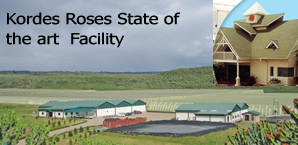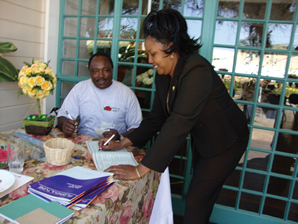Kordes Roses East Africa
 It has now been 30 Years since Kordes started its activities in East Africa, in Kenya to be precise. This was the first planting done at Oserian flowers in August 1984. The plants were delivered from Israel and were six-month bushes. At the time no-one knew what the effect of this planting would be…..that it would lead to a huge industry, and that East Africa would become a key player in the international rose business. As the rose industry in East Africa has changed over the past 30 years, so has Kordes in its involvement in this region. Initially, Kordes worked through an agent and over the years moved on to more direct involvement with the industry in East Africa. This has led to a superb trialling facility in Karen as well as a modern production facility in Naivasha.
It has now been 30 Years since Kordes started its activities in East Africa, in Kenya to be precise. This was the first planting done at Oserian flowers in August 1984. The plants were delivered from Israel and were six-month bushes. At the time no-one knew what the effect of this planting would be…..that it would lead to a huge industry, and that East Africa would become a key player in the international rose business. As the rose industry in East Africa has changed over the past 30 years, so has Kordes in its involvement in this region. Initially, Kordes worked through an agent and over the years moved on to more direct involvement with the industry in East Africa. This has led to a superb trialling facility in Karen as well as a modern production facility in Naivasha.
Kordes has always supported new developments on a regional level across the world, as it is important to expand business without any preconceptions. The most interesting aspect in East Africa is the diverse environmental conditions that can be found in the region. All micro-climates lead to different results, from small headed roses in high humidity areas to large headed roses grown at high altitude. This forms part of the challenge for Kordes, which is that we have to supply our customers with the best possible varieties under their conditions for optimal commercial success.
The last 30 years have had their ups and downs. Primarily the El Niño effect during the 1997/1998 season, and economic and political factors have each presented their own issues. However, these challenges have shown the resilience of the entrepreneurs in the successful floricultural industry in East Africa. Varieties In the past, rose growers in Africa would go to Europe to horticultural fairs to see new varieties and, more often than not, get access to these varieties after release through European growers. Thirty years after the start of the business here, the dynamics have changed 180 degrees to the point where most of the new varieties are introduced by East African rose growers. In actual fact, for variety decision it is better to look at local facilities than those grown under different conditions in other continents.
 Although all breeding is done centrally at the main company in Northern Germany, the selection process is rapidly tried out in regional test facilities across the world. The test facilities in Karen, where a rigorous selection procedure is followed as a result of experience in East Africa, are world class. The newest techniques are trialled regularly to see if this can lead to improved performance of rose crops. The test facility started off in a wooden greenhouse as well, and has over the years progressed to modern controlled-condition facilities.
Although all breeding is done centrally at the main company in Northern Germany, the selection process is rapidly tried out in regional test facilities across the world. The test facilities in Karen, where a rigorous selection procedure is followed as a result of experience in East Africa, are world class. The newest techniques are trialled regularly to see if this can lead to improved performance of rose crops. The test facility started off in a wooden greenhouse as well, and has over the years progressed to modern controlled-condition facilities.
As a sign of understanding the challenges of the industry, Kordes has set up a clean stock section in order to supply propagation material for mother stock to its customers. This is particularly with respect to Agrobacterium Tumefasciens at the moment, but also extends to viruses, which will in the future play a larger role with regard to Phytosanitary requirements.
Kordes has also taken experimental trialling one step further by introducing varieties, through Kreative Roses in Naivasha, on to the market place thereby creating more security for growers when choosing new varieties for planting.
Technical
Technical changes have also taken place over the last 30 years. Initially, all production was in the soil in wooden greenhouses. This slowly started to change to more modern facilities, as experience led to more confidence in growing techniques. Most of this change took place at the beginning of this century.More environmental awareness also led to new techniques aimed at decreasing the impact of the industry on the natural resources of the region. Computerised irrigation is now the norm up from simple (but efficient) venturi systems. Improved irrigation techniques have led to more efficient and better production. A number of growers use climate controlled greenhouses in order to get the most out of their crops. There is still much, in terms of production and quality, to be gained by better climate control.
Propagation of rose plants has gone from a 6-9 month process to a 5 to 7 week process through the use of modern propagation units leading to more flexibility for rose growers in their variety choice. What is important is that technology should be adapted to local conditions in order to improve performance and not just in order to have a smart production unit!
Cut rose market
From a market perspective, East Africa has become the leading import supplier to the auction clocks. From disdainfully looking at new suppliers from some obscure country, rose buyers now accept produce coming from the region as being of superior quality. It is critical to maintain this momentum as competition will push growers for better results.
The main driving force behind this success; is the fact that all participants in the industry have become more professional over the past years. From production facilities to logistics to presentation to the point of sales, an overall improvement has led to better efficiency whilst at the same time maintaining high quality and dependability. We can see this clearly as producers go further down the value chain and supply retailers all over Europe as well as the Far East. At the moment it is impossible to envisage most of the markets without roses from East Africa.
New marketing concepts have been taken up by the growers in East Africa with gusto, and this has mostly led to good commercial results. However, as the supply chain becomes more critical of the produce it handles, it is imperative that the region keeps looking for improved ways to present the product on the market place. This is especially the case with regard to higher expectations of shelf-life as well as the final performance in the consumer’s living rooms.
Kordes has been involved in all this development and we will endeavour keep on going as a favoured breeder for another 30 years in this region!


